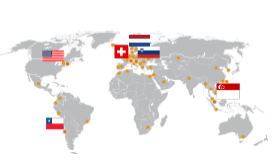January 3, 2023
THE USE OF RYSEN™ AND EPIDURAL ELECTRICAL STIMULATION (EES) FOR REHABILITATION IN A COMPLETE PARAPLEGIC PATIENT- CASE REPORT

NeuroRestore, Centre Hospitalier Universitaire Vaudois (CHUV), Lausanne Switzerland

Dr Jocelyne Bloch, co-director of NeuroRestore

Professor Dr Grégoire Courtine, co-director of NeuroRestore

Authors of this report
Summary of the case study
Introduction: After a complete spinal cord injury (SCI), neurological assessments show no spared motor or sensory function below the level of injury. Decreased mobility after SCI is associated with a heightened risk of a decrease in both life satisfaction and quality of life (1). Epidural electrical stimulation (EES) is a treatment approach to reactivate the spinal cord below the injury. An implantable pulse generator delivers bursts of electrical stimulation at specific locations over the spinal cord and with a timing that coincides with the intended leg movements. This epidural electrical stimulation (EES) targeting the dorsal roots of lumbosacral segments reactivates the spinal cord below the injury and amplifies the residual commands from the brain. EES immediately restores stepping in people with severe spinal cord injury (2).
Case description: We present a case of an intensive rehabilitation combining EES and physical therapy in a complete traumatic spinal cord injury (AIS-B, T6-T10). A 29-year-old male patient was included in the clinical research study STIMO (STImulation Movement Overground) and EES was implanted in July 2020 (2). Then, the patient was trained to stand and to walk with EES during five months, with 4 sessions/week. The sessions of physical therapy included trunk stability, leg reinforcement and functional movements. The bodyweight support (BWS) of the RYSEN™ was necessary during the early phase of the walking rehabilitation.
Results: At the end of the rehabilitation, the patient was able to stand 21 seconds without assistive device and to walk 56 meters with a walker without BWS while the stimulation is turned on.
Conclusion: The RYSEN™ was a significant help to ensure the safety of the walking rehabilitation. The adjustment of the bodyweight support allows the therapist to work efficiently with the progress of the patient. Furthermore, this case shows that EES and intensive physical therapy was effective to improve motor function and walking ability in a patient with thoracic spinal cord injury.
Clinical Experience
We would like to share our clinical experience of a patient with a complete thoracic spinal cord injury. The patient’s experience with the intensive episode of care and improved outcomes motivated us to share how the RYSEN™ combined with EES can be incorporated into a rehabilitation program with this patient population.
The main results have been published in the following publication:
Rowald A, Komi S, Demesmaeker R et al., Activity-dependent spinal cord neuromodulation rapidly restores trunk and leg motor functions after complete paralysis. Nature Medicine 2022 Feb;28(2):260-271.
Age and condition of the patient
- The patient was 29 years old at the beginning of his intensive rehabilitation in STIMO. He was diagnosed with a complete paralysis ASIA-B, with a sensory and motor neurological level of T7 (right and left). The origin of the lesion is traumatic, following a motorbike accident in 2019. He was independent for the transfers and for moving around with his wheelchair. However, he was not able to stand up or to walk.
Goals of the patient
- Walking with walker without support indoors and outdoors
- Going up and down the stairs
Patient History
- The patient was implanted with EES the 5th of August 2020. Then, the stimulation was optimized for one month. The rehabilitation started directly after the optimization and ended five months later. Afterwards, the patient continued to train at home using EES.

Figure 1: Patient Treatment Phases
Before Rehabilitation
Video 1: Assessment pre-rehabilitation. Standing with EES, with the walker and 10% BWS.
Video 2: Assessment pre-rehabilitation. Walking with EES, with the walker and 35% BWS.
Pre-rehabilitation Assessment: 14.09.2020 (CHUV)
The following assessments were performed after the optimization of the stimulation.

Table 1: Assessment pre-rehabilitation with EES on and EES off.
Evaluation of motor function (EES off)

Table 2: Evaluation pre-rehabilitation of motor function (EES off)
Treatment with EES and RYSENTM
- Dosage of therapy:
The duration of the intensive rehabilitation was 5 months. The patient had four sessions of three hours per week.
Initially, the RYSEN™ was used during each therapy session for at least one to two hours. The RYSEN™ was necessary to ensure patient safety during gait rehabilitation and during standing balance exercises. As the patient progressed, the RYSEN™ bodyweight support could be reduced and finally totally removed.
- Other therapies than the robotic :
In addition to walking, standard physiotherapy sessions were carried out with or without EES :
-Trunk control exercises (e.g. sitting position, four legged position)
-Leg strengthening (e.g. leg press, voluntary movement)
-Leg stretching and management of spasticity
-Pain management
-Other functional activities (outdoor walking, going up and down the stairs)
Video 3: Gait training with crutches with EES and 25% BWS
Video 4: Trunk control and core training with EES
At the end of EES-Supported Rehabilitation
Video 5: Assessment post-rehabilitation: Standing with EES, without BWS and with activity of the upper limb.
Video 6: Assessment post-rehabilitation: Walking with EES, with the walker, without BWS.
Post-rehabilitation assessment: 22.02.21 (CHUV)

Table 3: Assessment post-rehabilitation with EES on and EES off
Evaluation of motor function (EES off)

Table 4: Evaluation post-rehabilitation of motor function (EES off)
Main Results with EES Walking Tests

Graph 1: 6 minute walk test (6MWT) in metres (m), with EES before rehabilitation and after 5 months

Graph 2: 10 minute walk test (10 MWT) at comfortable and fast speed, in metres per second (m/s), with EES before rehabilitation and after 5 months

Graph 3: Score of Walking Index for Spinal Cord Injury (WISCI), with EES, before the rehabilitation and after 5 months.

Graph 4: Duration in seconds (s) of standing position without arms support with EES, before the rehabilitation and after 5 months.

Graph 5: Score of Berg test with EES, before the rehabilitation and after 5 months.
Summary of the Results
Following the five months intensive rehabilitation, we could observe major improvement of the strength of the core and of the functional activities with EES :
- He was able to walk independently with a walker indoor and outdoor (55 meters) ( video 6 and graph 1).
- He was able with help to go up and down the stairs.
- He was able to stand 21 seconds without assistive device and without the RYSEN™( graph 4).
- He was able to stand and to perform an activity of the upper extremities and to stand up with walker more than one hour (video 5).
- There was an improvement on the scores of the following functional scales: 6MWT, 10MWT, WISCI, Berg score (graph 1, 2, 3 and 5).
Conclusion
In conclusion, intensive rehabilitation combining EES and RYSEN™ was beneficial. It improved functional activities in a complete paraplegic patient. The RYSEN™ ensured the safety of the early phase of the rehabilitation. The adjustment of the BWS allows to work efficiently with the progress of the patient.
Bibliography
(1) Nam KY, Kim HJ, Kwon BS, Park JW, Lee HJ, Yoo A. Robot-assisted gait training (Lokomat) improves walking function and activity in people with spinal cord injury: a systematic review. J Neuroeng Rehabil. 2017 Mar 23;14(1):24. doi: 10.1186/s12984-017-0232-3. PMID: 28330471; PMCID: PMC5363005.
(2) Rowald, A., Komi, S., Demesmaeker, R., Baaklini, E., Hernandez-Charpak, S. D., Paoles, E., … & Courtine, G. (2022). Activity-dependent spinal cord neuromodulation rapidly restores trunk and leg motor functions after complete paralysis. Nature Medicine, 28(2), 260-271.
About Us



